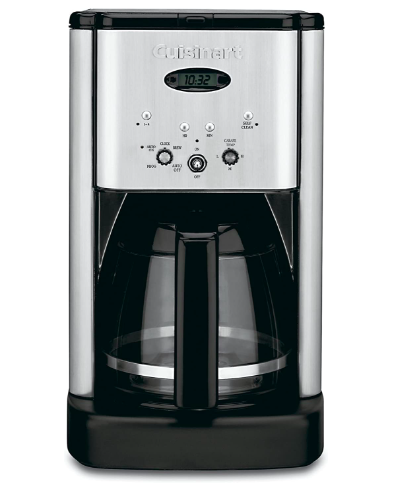How to Clean Your Cuisinart Coffee Maker: A Complete Guide:
As a coffee enthusiast, I understand that nothing beats the taste of a freshly brewed cup of coffee first thing in the morning. But did you know that the secret to maintaining that great taste lies in how well you clean your coffee maker? Many people who own a Cuisinart coffee maker frequently ask about how to clean a Cuisinart coffee maker and how often to clean.
In this guide, I’ll walk you through the process of how to clean a Cuisinart coffee maker to guarantee the perfect cup every time.
Introduction: Why Cleaning Your Cuisinart Coffee Maker is Essential
Your Cuisinart Coffee Maker is more than just an appliance. It’s the cornerstone of your morning routine, the first thing you reach for to kick-start your day. It’s your personal barista, always ready to provide you with the perfect cup of coffee, exactly how you like it. But like any barista, it needs the right care and attention to continue performing at its best.
1) Prevent Build Up
Over time, your coffee maker can become a haven for coffee residue, oils, and even mineral deposits from your water supply. These buildups don’t just affect the inner workings of your machine, clogging up the filters and slowing down the brewing process. More importantly, they can significantly alter the taste of your coffee, turning your delightful morning brew into a bitter disappointment.
When you sip on a cup of coffee brewed in a dirty coffee maker, you’re not just getting the rich, aromatic coffee flavors you love. You’re also tasting all the old coffee oils and hard water minerals that have been left behind from previous brewing cycles. This can result in a stale, off-putting taste, which can ruin your coffee experience.
2) Health Factors
Also, from a health perspective, maintaining a clean coffee maker is essential. Old, damp coffee grounds can provide a breeding ground for bacteria and mold. By not cleaning your coffee maker, you might be exposing yourself to these unwanted elements each time you brew a pot.
3) Maximizing Lifespan of Coffee Maker
Lastly, consider the lifespan of your coffee maker. The build-up of these residues and minerals can lead to wear and tear over time. It can stress the heating element and other mechanical parts, potentially leading to breakdowns. Regular cleaning helps to ensure that your coffee maker remains in good working condition for years to come.
So, for the love of all things coffee, it’s essential to learn and regularly follow the process of cleaning your Cuisinart Coffee Maker. The result will be a machine that functions optimally, a safer environment for brewing, and most importantly, a better-tasting cup of coffee. After all, isn’t that the ultimate goal for any coffee lover?
Understanding the Parts of Your Cuisinart Coffee Maker
Understanding the different parts of your coffee maker can help in cleaning it more efficiently. Let’s break it down:
The Reservoir:
This is where the magic begins. The reservoir is the part of your coffee maker where you pour in water. This water is then heated and used to brew your coffee. Over time, especially if you use hard water, it can accumulate mineral deposits that can affect the taste of your coffee and the overall performance of the machine.
The Carafe:
Also known as the coffee pot, the carafe is where the brewed coffee ends up. It’s typically made of glass or thermal materials to keep your coffee hot for longer periods. It’s also where coffee stains and oils can accumulate over time, which can alter the flavor of your coffee if not cleaned regularly.
The Filter Basket:
This holds your coffee filter and the coffee grounds. As water flows through it, the coffee is extracted, leaving behind the grounds. Over time, coffee residue can build up in the basket, which can impact the taste and aroma of your coffee if it’s not cleaned regularly.
The Brew Basket Cover:
This part covers the filter basket and has a showerhead that disperses water evenly over the coffee grounds to ensure optimal extraction.
The Control Panel:
This is where you control the settings of your coffee maker. Depending on your Cuisinart model, you might have options to set the clock, program a brewing time, choose the coffee strength, or select the carafe temperature.
The Heating Plate:
Situated beneath the carafe, the heating plate keeps your brewed coffee warm until you’re ready to drink it. However, if coffee spills on it and isn’t cleaned, it can lead to burning and staining, which can affect the machine’s performance.
The Water Filter:
Some Cuisinart models come with a charcoal water filter. This feature purifies the water before brewing, removing chlorine, calcium, and bad tastes or odors for the purest coffee flavor. The filter should be replaced every 60 days or after 60 uses.
Understanding each part of your coffee maker can make the cleaning process easier and more effective, ensuring that your machine continues to deliver a perfect cup of coffee every time.
Step by Step Guide to Cleaning Your Cuisinart Coffee Maker
Now that we’re familiar with the parts, let’s dive into the cleaning process.
1) Gather Your Cleaning Supplies:
You’ll need fresh water, white vinegar, mild dish soap, a soft cloth or sponge, and a soft-bristled brush.
2) Remove Removable Parts:
Begin by unplugging your coffee maker. Remove any removable parts, such as the carafe, filter basket, and, if applicable, the water filter. These parts will be cleaned separately.
3) Clean the Carafe:
Fill the carafe with warm soapy water. Use a soft cloth or sponge to wipe it down, paying close attention to the bottom where oils and residue can accumulate. Rinse thoroughly and let it dry.
4) Clean the Filter Basket:
For Regular Filters
Just discard after use and rinse the basket with warm water.
For Permanent Filters
Hand wash with warm soapy water or clean it in the top rack of your dishwasher if it’s dishwasher-safe
5) Clean the Water Reservoir:
Fill the water reservoir with equal parts of white vinegar and water. Turn on the coffee maker and let it run a brewing cycle. The vinegar will break down the mineral deposits and other residues. After the brewing cycle completes, let the vinegar solution sit in the carafe for about an hour.
6) Rinse Thoroughly:
After an hour, empty the carafe and rinse it with fresh water. Fill the water reservoir with fresh water and run another brewing cycle. Repeat this process a couple of times to ensure all vinegar traces are completely rinsed away.
7) Clean the Outer Surface:
Wipe down the outer surface of your coffee maker with a soft damp cloth. Ensure the control panel and heating plate are also cleaned.
8) Reassemble the Coffee Maker:
Once all the parts are dry, reassemble your coffee maker. If your machine has a water filter, replace it as per the manufacturer’s recommendations.
This comprehensive cleaning process will help ensure your Cuisinart Coffee Maker continues to operate effectively and deliver great-tasting coffee. As a general rule, a deep clean like this should be performed at least once a month, with regular cleaning of the carafe and filter basket after each use..
How Often Should You Clean Your Cuisinart Coffee Maker?
Regarding how to clean a Cuisinart coffee maker, maintaining a clean coffee maker is crucial to ensuring it functions properly and delivers the best tasting coffee. Here’s an expanded guide on how often you should clean each part of your Cuisinart Coffee Maker:
Carafe and Filter Basket:
These parts come into direct contact with coffee and should ideally be cleaned after every use. Cleaning them prevents the buildup of coffee residue and oils that can alter the taste of your coffee. Simply rinsing them with warm soapy water and thoroughly drying them before the next use can suffice for this regular cleaning.
Water Reservoir:
The reservoir doesn’t need to be cleaned as frequently as the carafe and filter basket, but it still requires regular attention. Depending on the hardness of your water, aim to clean the reservoir at least once a month. This involves running a brewing cycle with equal parts of vinegar and water to break down mineral deposits, followed by several cycles with fresh water to rinse it out thoroughly.
Water Filter:
If your Cuisinart model comes with a water filter, replace it every 60 days or after 60 uses to ensure the best water quality for your coffee. This will vary based on the specific instructions provided by Cuisinart for your coffee maker model.
Overall Deep Cleaning:
Apart from the regular cleaning mentioned above, a complete deep cleaning of your coffee maker should be performed at least once a month. This cleaning will involve all the parts of your coffee maker and will help to maintain its efficiency, taste of coffee, and extend its lifespan.
Remember, while these guidelines serve as a general rule of thumb, always refer to the manufacturer’s instructions for specific cleaning and maintenance advice for your particular Cuisinart Coffee Maker model.
Troubleshooting Common Problems
Coffee makers, like any other appliances, may sometimes encounter issues. Here are some common problems that you might face with your Cuisinart Coffee Maker, and some troubleshooting tips:
Coffee Tastes Bad:
If your coffee tastes off, it could be due to several reasons. Old coffee beans, the wrong coffee-to-water ratio, or unclean parts of the machine could be the culprits. Cleaning your coffee maker regularly and thoroughly, using fresh coffee beans, and ensuring the right proportions can help solve this problem.
Coffee Maker Won’t Brew:
If your coffee maker isn’t brewing, check to make sure it’s plugged in and the switch is on. If it still won’t brew, it could be that mineral deposits have built up inside. Try descaling the coffee maker with a mixture of vinegar and water.
Coffee Maker is Leaking:
Leaks can occur if the coffee maker is overfilled. Always ensure that you’re adding the correct amount of water. If it continues to leak, it could indicate a problem with the seals or valves. In this case, you may need to seek professional help.
Coffee is Not Hot Enough:
If the coffee isn’t hot enough, the heating plate could be malfunctioning. Ensure that it’s clean and free of any spilled coffee or debris. If it’s clean and the coffee still isn’t hot enough, the heating element may be faulty and require professional repair.
Brewing Takes Too Long:
If the brewing process is taking longer than it should, it could be due to a buildup of mineral deposits within the machine, especially if you’re using hard water. Regularly descaling your coffee maker can help.
Remember, if your coffee maker is under warranty and you’re having trouble with it, it’s best to contact Cuisinart’s customer service or a professional appliance repair service. Attempting to repair it yourself could void the warranty.
Conclusion: Enjoy Your Cleaner, Better Tasting Coffee!
With a clean coffee maker, you’ll enjoy a great cup of coffee every time.
So why wait?
It’s time to clean your Cuisinart coffee maker!
How to Clean a Cuisinart Coffee Maker FAQs
1. Can I use a solution other than vinegar to clean my coffee maker? Yes, there are specific coffee maker cleaning solutions available in the market.
2. How often should I replace my coffee maker? With proper care and maintenance, a coffee maker can last several years before needing replacement.
3. Can I use bleach to clean my coffee maker? No, bleach can be too harsh on the machine and leave a residue that could affect the taste of your coffee.
4. Is it necessary to clean a coffee maker after every use? While it’s not necessary to deep clean after every use, you should clean the carafe and filter basket regularly.
5. Why is my coffee bitter? This can be due to over-extraction from the coffee grounds or buildup of coffee oils and residue in the coffee maker. Regular cleaning can solve this issue.




